Related Research Articles

Johann Jakob Scheuchzer was a Swiss physician and natural scientist born in Zürich. His most famous work was the Physica sacra in four volumes, which was a commentary on the Bible and included his view of the world, demonstrating a convergence of science and religion. It was richly illustrated with copperplate etchings and came to be called the Kupfer-Bibel or "Copper Bible".

The Linth is a Swiss river that rises near the village of Linthal in the mountains of the canton of Glarus, and eventually flows into the Obersee section of Lake Zurich. It is about 50 kilometres (31 mi) in length.
This article contains information about the literary events and publications of 1799.
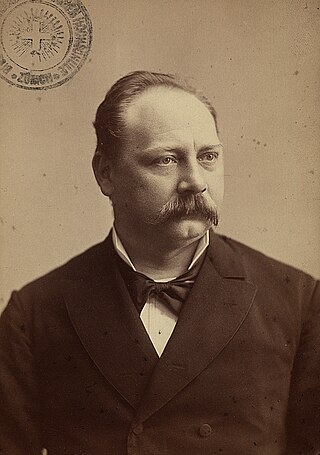
Eugène Rambert, was a Swiss author and poet.
Juste Daniel Olivier, Swiss poet, was born in Eysins in the canton of Vaud; he was brought up as a peasant, but studied at the college of Nyon, and later at the academy of Lausanne.
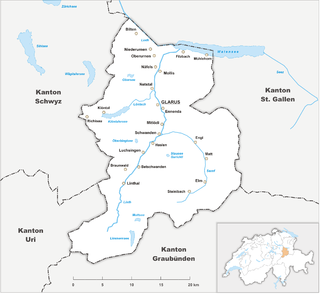
The canton of Glarus is a canton in east central Switzerland. The capital is Glarus. The population speaks a variety of Alemannic German. The majority of the population (81%) identifies as Christian, about evenly split between Protestants and Catholics.

Altdorf is a municipality in Switzerland. It is the capital of the Swiss canton of Uri and retains historic town privileges. It is the place where, according to the legend, William Tell shot the apple from his son's head.

Glarus is the capital of the canton of Glarus in Switzerland. Since 1 January 2011, the municipality Glarus incorporates the former municipalities of Ennenda, Netstal and Riedern.
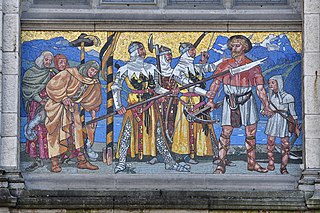
William Tell is a folk hero of Switzerland. According to the legend, Tell was an expert mountain climber and marksman with a crossbow who assassinated Albrecht Gessler, a tyrannical reeve of the Austrian dukes of the House of Habsburg positioned in Altdorf, in the canton of Uri. Tell's defiance and tyrannicide encouraged the population to open rebellion and a pact against the foreign rulers with neighbouring Schwyz and Unterwalden, marking the foundation of the Swiss Confederacy. Tell was considered the father of the Swiss Confederacy.

The Walensee, also known as Lake Walen or Lake Walenstadt from Walenstadt, is one of the larger lakes in Switzerland, with about two thirds of its area in the Canton of St. Gallen and about one third in the Canton of Glarus. Other towns and villages at the lake include Weesen, Quinten, Quarten, and Murg.

Johann Jakob von Tschudi was a Swiss naturalist, explorer and diplomat.
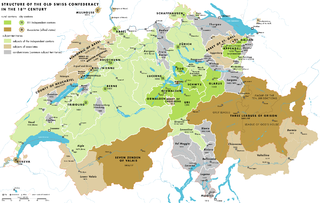
The early modern history of the Old Swiss Confederacy and its constituent Thirteen Cantons encompasses the time of the Thirty Years' War (1618–1648) until the French invasion of 1798.

Hans Herzog was a Swiss army officer, and was elected Switzerland's General during the Franco-Prussian War.

The Battle of Morat took place during the Burgundian Wars (1474–1477) that was fought on 22 June 1476 between Charles the Bold, the Duke of Burgundy, and a Swiss Confederate army at Morat (Murten), about 30 kilometres from Bern. The result was a crushing defeat for the Burgundians at the hands of the Swiss.

Jean-Pierre de Crousaz was a Swiss theologian and philosopher. He is now remembered more for his letters of commentary than his formal works.

Johann Gottfried Ebel was the author of the first real guidebook to Switzerland.
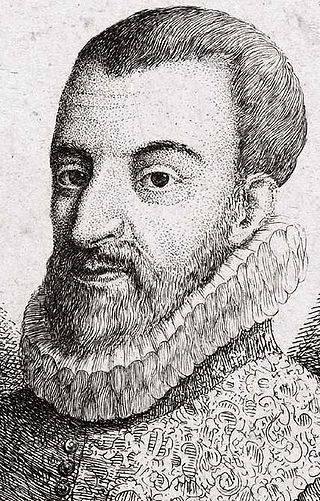
AegidiusTschudi was a Swiss statesman and historian, an eminent member of the Tschudi family of Glarus, Switzerland. His best-known work is the Chronicon Helveticum, a history of the early Swiss Confederation.

The Treaty of Baden, signed 7 September 1714 in Baden, Switzerland, made peace between France and the Holy Roman Empire. Together with the Treaties of Utrecht and Rastatt, it was one in a series of agreements ending the 1701 to 1713 War of the Spanish Succession.

The Hausstock is a mountain in the Glarus Alps, at an elevation of 3,158 m (10,361 ft) on the border between the cantons of Glarus and Graubünden. It overlooks the valleys of Linth and Sernf rivers in Glarus, and the valley of the Vorderrhein river in Graubünden. The Hausstock was the site of the 1799 withdrawal of the Russian army under General Alexander Suvorov. A well-known destination already in the nineteenth century with British and American climbers, the mountain remains popular with mountain climbers and skiers.
References
- Coolidge, William Augustus Brevoort (1911). . In Chisholm, Hugh (ed.). Encyclopædia Britannica . Vol. 27 (11th ed.). Cambridge University Press. pp. 349–350.
- ↑ Coolidge, William Augustus Brevoort (1911). . Encyclopædia Britannica . Vol. 27 (11th ed.). pp. 349–350, see para 2.